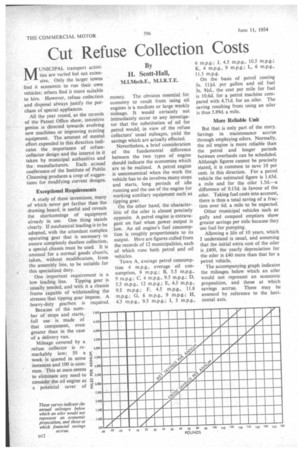Cut Refuse Collection Costs
Page 82

If you've noticed an error in this article please click here to report it so we can fix it.
By H. Scott-Hall, M.I.Mech.E., M.I.R.T.E.
MUNICIPAL transport activities are varied but not extensive. Only the larger towns find it economic to run their own vehicles; others find it more sLitable to hire. However, refuse collection and disposal always justify the purchase of special appliances.
All the year round, as the records of the Patent Office show, inventive genius is directed towards evolving new machines or improving existing equipment. The amount of mental effort expended in this direction indicates the importance of refusecollector design and the interest in it taken by municipal authorities and the manufacturers. Each annual conference.of the Institute of Public Cleansing produces a crop of suggestions for modifying current designs.
Exceptional Requirements A study of these inventions, many of which never get farther than the drawing board, is useful and reveals the shortcomings of equipment already in use. One thing stands clearly. If mechanical loading is to be adopted, with the attendant complex operating gear that is necessary to ensure completely dustless collection, a special chassis must be used. It is unusual for a normal goods chassis, taken, without. modification, from the assembly line, to be suitable for this specialized duty.
One important requirement is a low loading line. Tipping gear is usually needed, and with it a chassis frame capable of withstanding the stresses that tipping gear impose. A heavy-duty gearbox is required.
Because of the number of stops and starts, full use is made of that component, even greater than in the case of a delivery van.
Mileage covered by a. refuse collector is remarkably low; 50 a week is quoted in some instances and 100 is common. This at once seems to eliminate any need to consider the oil engine as a potential saver of money. The obvious essential for economy to result from using oil engines is a medium or large weekly mileage. It would certainly not immediately occur to any investigator that the substitution of oil for petrol would, in view of the refuse collectors' usual mileages, yield the savings which are actually effected.
Nevertheless, a brief consideration of the fundamental difference between the two types of engine should indicate the economies which are to be realized. A petrol engine is uneconomical when the work the vehicle has to do involves many stops and starts, long periods of idle running and the use of the engine for working auxiliary equipment such as tipping gear.
On the other hand, the characteristic of the oiler is almost precisely opposite. A petrol engine is extravagant on fuel when power output is low. An oil engine's fuel consumption is roughly proportionate to its output. Here are figures culled from the records of 12 municipalities, each of which runs both petrol and oil vehicles.
Town A, average petrol consumption 4 m.p.g., average oil consumption, 9 m.p.g.; B, 3.5 m.p.g., 9 m.p.g.; C, 4 m.p.g., 9.5 m.p.g.; D, 5.5 m.p.g., 12 m.p.g.; E, 4.3 m.p.g., 9.5 m.p.g.; F, 4.5 m.p.g., 11.8 m.p.g.; G, 6 m.p.g., 9 m.p.g.; H, 4.5 m.p.g., 9.5 m.p.g.; I, 3 m.p.g., 6 m.p.g.; J. 4.5 m.p.g., 10.5 m.p.g.; K, 4 m.p.g., 9 m.p.g.; L, 6 m.p.g., 11.5 m.p.g.
On the basis of petrol costing 3s. 111d, per gallon and oil fuel 3s. 91d., the cost per mile for fuel is 10.6d. for a petrol machine compared with 4.71d. for an oiler. The saving resulting from using an oiler is thus 5.89d. a mile.
More Reliable Unit
But that is only part of the story. Savings in maintenance accrue through employing oilers. Normally, the oil engine is more reliable than the petrol and longer periods between overhauls can be scheduled. Although figures cannot be precisely stated, it is common to save 10 per cent. in this direction. •For a petrol vehicle the estimated figure is 1.65d. a mile and for the oiler 1.5d.—a difference of 0.15d. in favour of the oiler. Taking fuel costs into account, there is thus a total saving of a fraction over 6d. a mile to be expected.
Other municipal vehicles such as gully and cesspool emptiers show greater savings per mile because they use fuel for pumping.
Allowing a life of 10 years, which I understand is usual, and assuming that the initial extra cost of the oiler is £400, the yearly depreciation for the oiler is £40 more than that for a petrol vehicle.
The accompanying graph indicates the mileages below which an oiler would not represent an economic proposition, and those at which savings accrue. These may be assessed by reference to the horizontal axis.




















































































































































